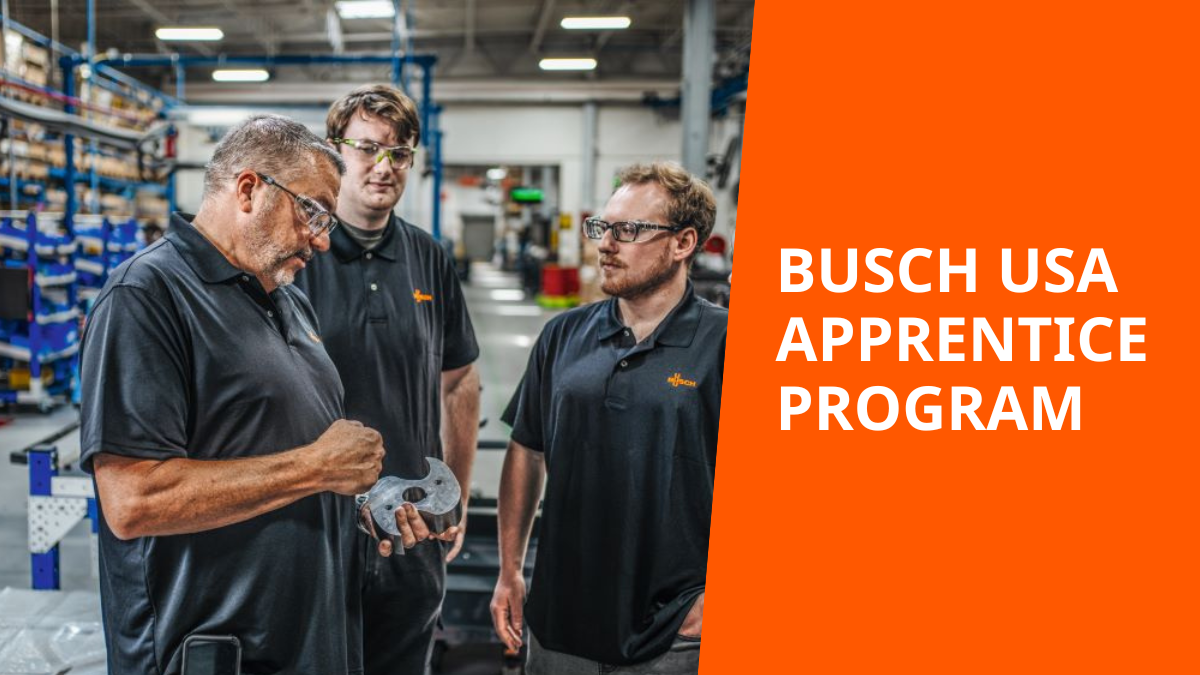
From left to right: Brian Stevenson, Technical Training Coordinator; Seth Hugenroth, Apprentice and Robert (Spencer) Gradel, Apprentice. Source: Busch Vacuum Solutions.
Students Launch Their Career with Busch USM Apprentice Program
In today’s competitive workforce, classroom training is only part of what it takes to secure a promising career. As Busch USA Manufacturing looks for applicants with hands-on experience and technical training to provide skilled manufacturing, the Busch apprentice program has been a proven way to develop future leaders. The program is currently designed for those interested in Precision Machining Technology and is registered and approved by the Virginia Department of Labor & Industry.
Led by Brian Stevenson, Technical Training Coordinator, the program is structured so that students obtain a comprehensive knowledge base by utilizing classroom, lab, and on-the-job (OTJ) training. Apprentices attend weekly evening classes at a local community college to obtain their Related Technical Instruction (RTI) hours. They learn how to read and interpret blueprints, use critical hand tools, set up and operate machine tools, and use precision measuring instruments to manufacture a wide range of parts and tools. For OTJ training, students work on-site at Busch during the day.
According to Brian, “Our apprentices have the opportunity to gain practical experience while earning their degree, which sets them up for a promising career as soon as they graduate.”
Like similar programs, Busch uses a hands-on approach. Apprentices put their education and skills into practice on the job. For example, apprentices, Seth Hugenroth and Robert (Spencer) Gradel worked together in the spirit of Total Productive Maintenance (TPM) and collaborated with production, maintenance and engineering to design and manufacture a new fixture to improve safety and efficiency. Specifically, with the above-mentioned teams, a “Three-Legged Stool” meeting was held to determine the "current state" or process to ensure the integrity of the project. From there, a concept was developed to address all issues and then presented back to the team for approval. Apprentices took on the challenge of modeling and creating drawings, as well as crafting a Bill of Materials. They then worked to produce the individual details to complete the build. “Though the project was small in scope, it provides an excellent opportunity for them to gain knowledge of how projects are conceived and produced to a successful closeout,” said Brian.
For the apprentices, the program offers a unique opportunity to become an integral part of Busch’s operations. Not only do they complete meaningful work, but they also have the chance to see their contributions in action. According to apprentice Robert Gradel, “It is rewarding to build a tool with your own two hands and see it used in the value chain.” Seth Hugenroth (apprentice) echoed this sentiment when he said, “It is satisfying to see a complex drawing develop into a process and then an actual part.” These are the kinds of hands-on experiences that give students the real-world experience they need.
The Busch apprentice program is an exceptional opportunity to gain both theory and practical experience. With a rigorous curriculum, hands-on training and a “can-do” attitude, students gain experience in all aspects of the trade.
According to Brian, “Our apprentices have the opportunity to gain practical experience while earning their degree, which sets them up for a promising career as soon as they graduate.”
Like similar programs, Busch uses a hands-on approach. Apprentices put their education and skills into practice on the job. For example, apprentices, Seth Hugenroth and Robert (Spencer) Gradel worked together in the spirit of Total Productive Maintenance (TPM) and collaborated with production, maintenance and engineering to design and manufacture a new fixture to improve safety and efficiency. Specifically, with the above-mentioned teams, a “Three-Legged Stool” meeting was held to determine the "current state" or process to ensure the integrity of the project. From there, a concept was developed to address all issues and then presented back to the team for approval. Apprentices took on the challenge of modeling and creating drawings, as well as crafting a Bill of Materials. They then worked to produce the individual details to complete the build. “Though the project was small in scope, it provides an excellent opportunity for them to gain knowledge of how projects are conceived and produced to a successful closeout,” said Brian.
For the apprentices, the program offers a unique opportunity to become an integral part of Busch’s operations. Not only do they complete meaningful work, but they also have the chance to see their contributions in action. According to apprentice Robert Gradel, “It is rewarding to build a tool with your own two hands and see it used in the value chain.” Seth Hugenroth (apprentice) echoed this sentiment when he said, “It is satisfying to see a complex drawing develop into a process and then an actual part.” These are the kinds of hands-on experiences that give students the real-world experience they need.
The Busch apprentice program is an exceptional opportunity to gain both theory and practical experience. With a rigorous curriculum, hands-on training and a “can-do” attitude, students gain experience in all aspects of the trade.
For questions regarding the program, contact Brian Stevenson at
brian.stevenson@buschmfg.com.
brian.stevenson@buschmfg.com.